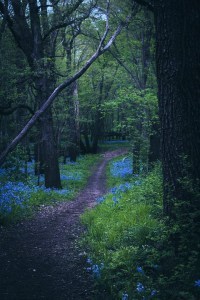Creating Mood In A Scene Using Light and Shadow
What’s one of the first things a person does to set the mood at home for a romantic evening? She turns down the lights. This simple adjustment is a big step toward creating a calm, receptive atmosphere. Just as the amount and quality of lighting will influence the way people feel in real life, we can adjust the mood for both characters and readers in our stories by playing with light and shadow.
Most everyone has familiar places that they’ve visited in daylight. But enter that same place at night and it becomes unfamiliar, with a totally different feel. By changing the amount and quality of light in a given place, you can shift the mood without changing the setting. For example, consider an example from a classic, L. M. Montgomery’s description of Birch Path, a recurring location in her Anne of Green Gables series:
 It was a little narrow, twisting path, winding down over a long hill straight through Mr. Bell’s woods, where the light came down sifted through so many emerald screens that it was as flawless as the heart of a diamond.
It was a little narrow, twisting path, winding down over a long hill straight through Mr. Bell’s woods, where the light came down sifted through so many emerald screens that it was as flawless as the heart of a diamond.
One can easily envision this scene under the trees. The green-tinged sunlight gives the scene a lighthearted, cheerful feel, and though the season isn’t mentioned, late spring or summer is inferred, simply by referencing the light.
But the same path traveled later in the day by a character in another frame of mind can look and feel vastly different. Here is Birch Path again, traveled by a more mature Anne in the third book of the series:
 Anne felt lonelier than ever as she walked home, going by way of the Birch Path and Willowmere. She had not walked that way for many moons. It was a darkly-purple bloomy night. The air was heavy with blossom fragrance—almost too heavy.
Anne felt lonelier than ever as she walked home, going by way of the Birch Path and Willowmere. She had not walked that way for many moons. It was a darkly-purple bloomy night. The air was heavy with blossom fragrance—almost too heavy.
The darkly-purple light, combined with Anne’s loneliness and the cloying odors, give the scene a heavy, melancholy feel that wasn’t there before.
(Do keep in mind this example is sourced from a classic, and when writing for a modern audience, we’d need to be careful about wandering too far down the flowery language path–pun intentional!)
Because light and shadow lies within the realm of universal symbolism, people tend to respond to light in a feral way: well-lit areas are deemed safer, putting us at ease, while darker spots have more weight and feel heavier both on the body and the spirit. When setting the mood for a scene, carefully consider the lighting. How much light is there? Where does it come from? Is it hard or soft, comforting or blinding? Is it constant and totally revealing, or does it allow for shadows and hidden places? Questions like these will serve as a guide for how to light a scene in order to set the desired mood.
Keep in mind however that light and shadow may represent something entirely different if one has taken the time to set up personal symbolism. Light itself may represent pain, exposure, risk, or danger to a character who lives safely below ground, or by the necessity of survival, is only able to come out at night. One needs only to look at vampire, werewolf, and demon fiction to see this played out within a story.
TIP: Should you adapt the universal symbolism of light and shadow to something personal which fits the personality of your point of view character or the reality of the world upon which the story is built, make sure to set this up so the meaning is always clear to readers.
Want more ideas on how to set the mood? Save this checklist to Pinterest.

Becca and I have a love affair with powerful description, the kind that does so much more than paints a picture for readers. Creating Mood is only one of ways setting can make your scenes rich and more meaningful.
If you’d like to find out how to also use it to characterize the story’s cast, reveal critical backstory naturally and effectively, steer the plot, reinforce emotion, provide tension & conflict, poke at your protagonist’s emotional wounds…and gosh, SO MUCH MORE, we hope you’ll check out our new Urban Setting and Rural Setting Thesaurus books. 
Writers Helping Writers
- Angela Ackerman's profile
- 1014 followers



